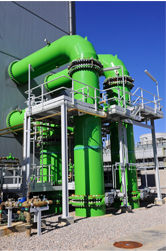During the Hungarian presidency of the first half of 2011, several strategic questions in the energy area were at the centre of attention. They included:
- The medium-term energy strategy for the 2011-2020 period.
- The European energy network plan up to 2020 and subsequent years.
- The 2020 Energy Efficiency Plan.
The Hungarian presidency also made efforts to suppress the technical obstacles that still continue in national regulations.
The Polish presidency was in office in the second half of 2011. In the energy area, it posed the creation and consolidation of the exterior energy policy as the central axis of its activity, with the objective of improving Europe's energy independence. Together with this objective, it also developed the European energy networks and delved deeper into a new energy strategy in the EU in the medium and long term.
One of the consequences of the accident at the Fukushima power plant has been improved safety at nuclear power plants. A few days after the event, EU states agreed to perform a safety evaluation on the 152 plants that are operating in Europe. This test allowed harmonising control criteria and implementing safety improvement plans at the same.
The Agency for the Cooperation of Energy Regulators (ACER) was started up in the first quarter of the year in Liubliana (Slovenia). At a European level, ACER complements and coordinates the work of national regulators within Europe. Its competencies include participation on creating Framework Directives for preparing European Network Codes; making binding, individual decisions on the terms and conditions of access and operational safety for cross-border infrastructures whenever the national regulators do not reach an agreement; advising European institutions about various questions related to energy; and supervision and presentation of reports to the European Parliament and Council.

The proposal is based on two pillars: taxing according to the atmospheric emissions of the specific energy and taxing on the quantity of energy consumed. The Communication with the Proposal for revision of the directive on the taxation of energy products and electricity was issued on 13 April 2011. Difficulties at achieving a consensus on the text have resulted in postponement of approval, which could foreseeably occur in 2012.
The 2011 Energy Efficiency Plan responds to a mandate from the European Council of 4 February 2011. Its objective is to specify actions to take advantage of the potential energy savings in buildings, transport and processes. This action is closely related to the Proposal for a Directive on Energy Efficiency.
On 22 May the Proposal for a Directive on Energy Efficiency was presented, which would repeal Directives 2004/8/EC and 2006/32/EC. The aim is to reach an improvement objective of 20% in the efficiency of energy consumption by 2020. It contemplates various actions: the legal obligation to create energy savings systems in all Member States (an annual cumulative savings of 1.5% in the market of residential and commercial end-use, with management falling upon energy companies); energy audits and the distribution of best practices at SMEs; control of the efficiency levels at new energy production facilities; and savings in the public sector.
Amendments are being prepared, both in the European Parliament and the Council.
The schedule estimated by the European Commission is to reach an agreement between the European Parliament, the European Council and the European Commission in the first semester of 2012. The directive would enter into force at the end of 2012.
The European Council and the Parliament adopted a Directive Proposal in 2010 (2010/30/EC) pertaining to the establishment of a framework for ecological design requirements (Ecodesign). Its purpose is to reduce the environmental impact of products, including energy consumption, throughout their lifecycle. The process that will end in approval of the directive is in progress.
In 2009 the Commission presented a strategic plan to accelerate the development and deployment of technologies with low CO2 emissions, the SET Plan. This plan includes measures related to planning, execution, resources and international cooperation in the field of energy technology. More in-depth work is being done to implement sector plans.
The carbon capture and storage (CSS) programme is part of the SET Plan. In May 2011, 78 demonstration projects were selected (NER 300 programme). In the second semester of 2012, the European Commission will select the projects that could receive financing from the NER 300 programme.
On 13 October 2008, the Commission presented its proposal for a Directive on consumer rights to the European Parliament and Council, which is based on Article 95 of the EU Treaty. The proposal for a Directive for consumer protection was approved by the Council on 15 June. On 23 June 2011, it was approved by the European Parliament. On 22 November it was published in the OJEU.
In June, the European Commission presented a Report on progress in creating internal gas and electricity markets in 2009 and 2010. The results of the transposition of the Third Package in the Member States were not reassuring, as it was expressed by the Report's authors. On 1 June 2011 no state had notified transposition, although four states had notified partial transposition.
The harmonisation of gas quality is a current objective of the European Commission because of Directive 2003/755/EC. There is a mandate to the CEN (European Committee for Standardization) for the standardization of various areas of activity, including those that have any type of relationship with the gas industry, in order to standardize gas quality in the EU-27 states. The final report approved on 12 December by the EN/BT WG 197, Gas Quality, will be presented to the European Commission. Execution of the complete mandate is expected to finalise in 2015.
The Gas Target Model is led by the Council of European Energy Regulators (CEER). The objective is to reflect upon and define a market model in the medium term for the natural gas sector in the EU. CEER published the final version on 1 December 2011.
The definition of a methodology for establishing and prioritising the Package of priority energy infrastructures has received notable attention by the services of the Commission throughout 2011. In August, the results of a public consultation were published on the concession authorisation procedure for infrastructure projects. In October, the regulation proposal of the infrastructure package was approved. A Common Position is expected from the Council in the spring of 2012.
The development of Network Codes in Europe is one of the main objectives of the Agency for the Cooperation of Energy Regulators (ACER). This agency will be in charge of preparing the framework directives of these codes, which will be prepared by ENTSOG. Network codes will facilitate physical commercial transactions and make it easier to configure the single European market. Maintaining the security of the supply, facilitating the integration of renewable energies (in particular, electricity generation) and contributing the most benefits to consumers are among the main objectives to be covered by network codes.
On 14 September, the European Parliament approved the Regulation on energy market integrity and transparency (REMIT). The objective is to prevent potential abuses and achieve the greatest possible transparency in the wholesale electricity and gas market. On 10 October, the CE published the proposal for the Regulation on energy market integrity and transparency (REMIT). It was published in the OJEU on 8 December.
In this area, we should recall that GRT Gaz, the manager of the French gas system (TSO), approved the construction of the gas pipeline system of the Ródano axis (Eridan).
On 19 October, the European Commission presented a plan amounting to 50 billion euros to improve the energy, digital and transport networks. In the press release, the European Commission communicated that the financing of energy networks will integrate the internal energy market even more, it will reduce the EU's energy dependency, and it will strengthen the security of the supply.
This plan is legally specified in the proposal of guidelines for the European energy infrastructure and in the repeal of Decision No 1364/2006/EC.
Annex I specified the priority gas corridors, including the North-South Interconnection in Western Europe (NSI West Gas), whose objective is to increase the interconnection capacities between these areas in order to increase the supply routes and increase gas deliveries between the same in the short term.
Other priority corridors are between the Baltic Sea, the Adriatic and the Black Sea (NSI East Gas, SGC); between the Caspian Sea area and central Asia towards the territory of the EU (South Gas Corridor, SGC); and the interconnections between the Baltic countries and Finland (BEMIT Gas).
In November 2009 a working group was created to advise the European Commission on intelligent networks. Work has continued since that time, with the aim of defining projects, unifying criteria and, in brief, advancing on the development of more efficient systems in the fields of energy networks. In an initial stage, work has been more constant in the area of electricity. In July 2011, the first catalogue of Smart Grid projects for the EU was presented.
Throughout most of 2011, the European Commission has been preparing the Energy Roadmap 2050, a document that contains ambitious objectives for reducing greenhouse gas emissions covered by the roadmap up to the date of reference. Specifically, it endeavours to reduce emissions by between 80% and 95% below 1990 levels. The methodology, which ended in approval of the document, was highly interactive. A Report from Parliament is expected by spring 2012 at the latest.
One of the fields that has been considered to be weak in the EU is the common exterior energy policy. In mid September, the Commission presented a Decision Proposal for the purpose of coordinating energy agreements between Member States and third countries. With this action, the European Commission endeavours to have more presence and present a stronger front with respect to gas suppliers to Europe.
Last 18 April 2011, the European Commission asked the CNE, as the leading regulator of the Southwest Electricity region, for a regional action plan within the context of the agreement by the Heads of State and Government of last 4 February, whereby the Internal Energy Market must be completed in 2014.
Said plan was prepared jointly by the regulators of Spain, France and Portugal following the recommendations of the Agency for the Cooperation of Energy Regulators (ACER). The region's regulators, among their priorities, will work on developing greater interconnection capacity of the Iberian Peninsula with the Central European region, as well as implementation of more efficient mechanisms for assigning capacity and managing congestion at inter-connections.

-
 Endesa
Endesa

